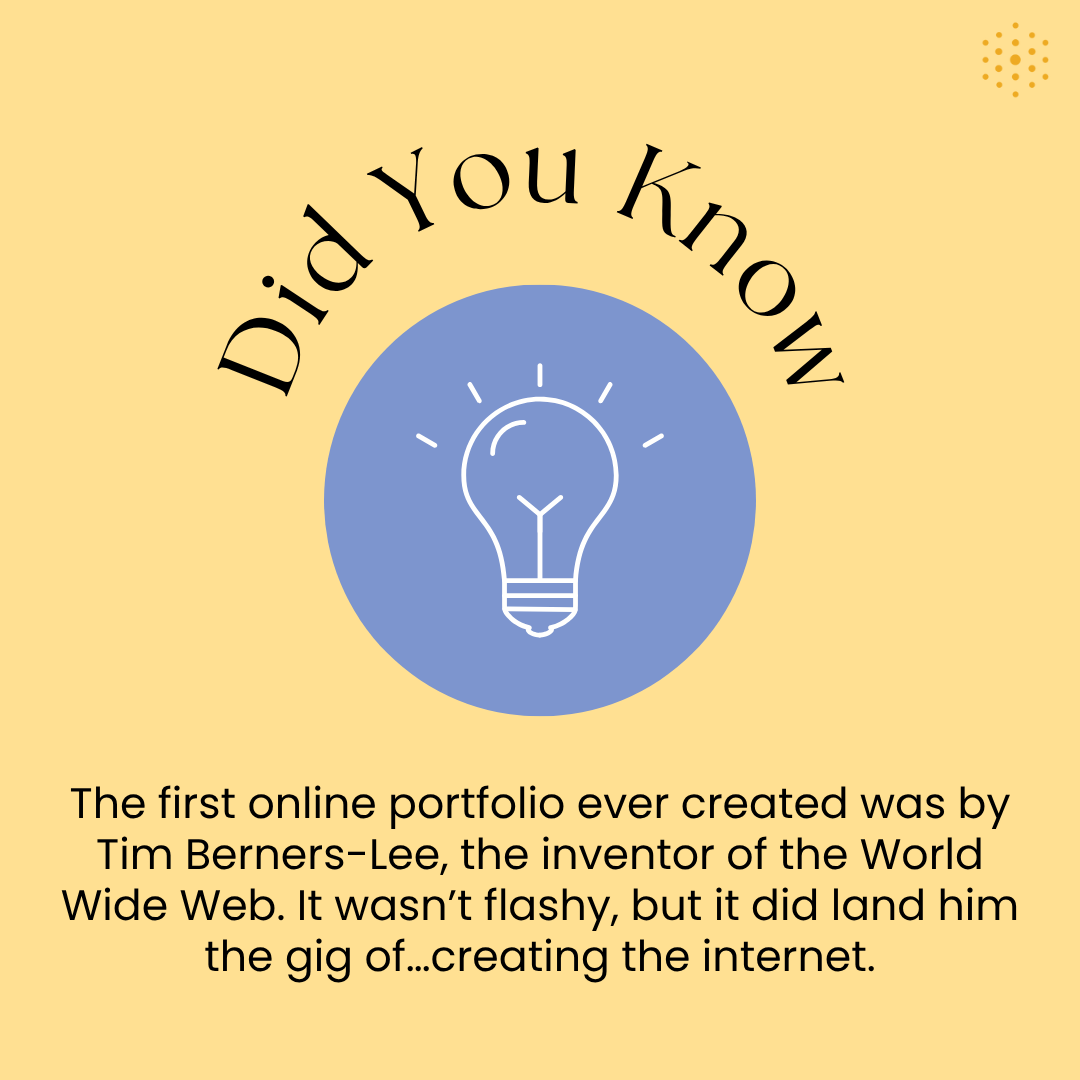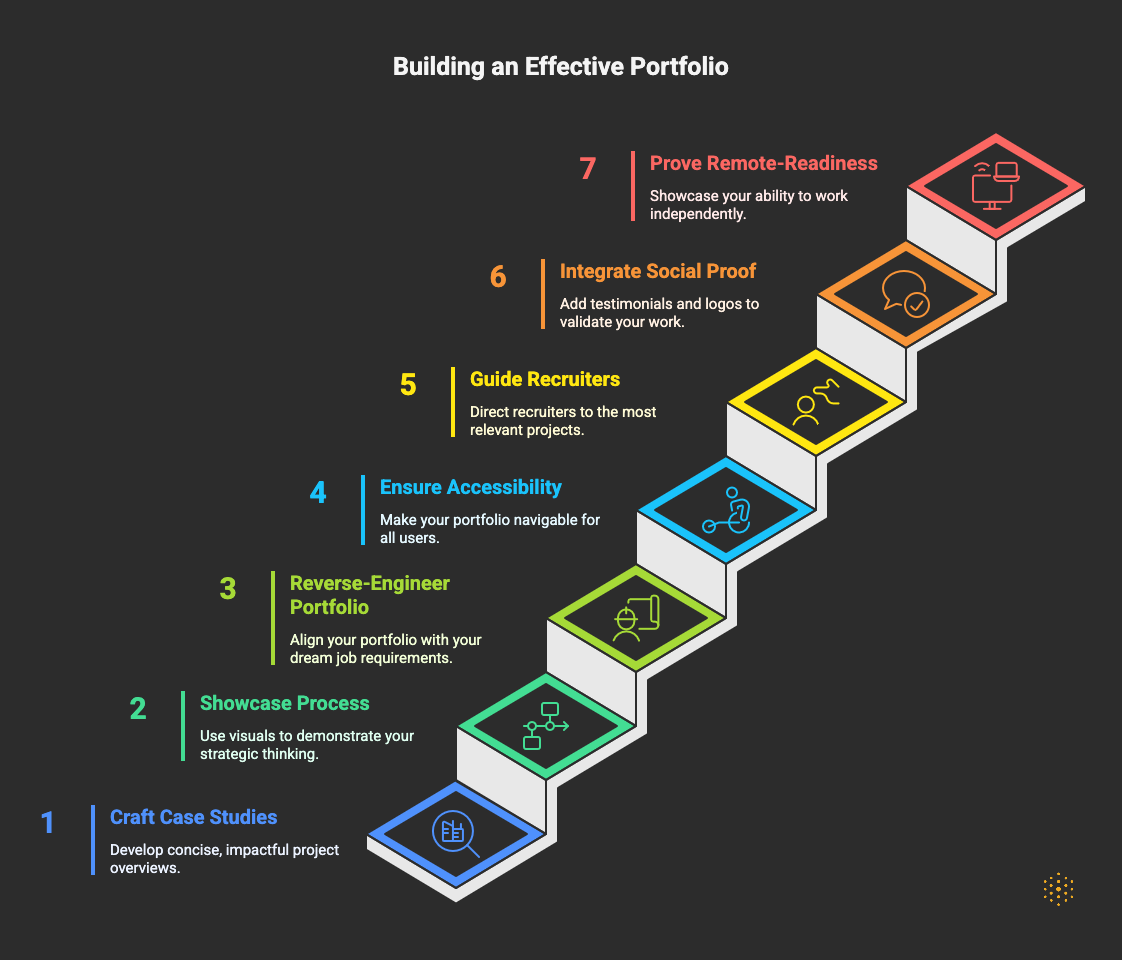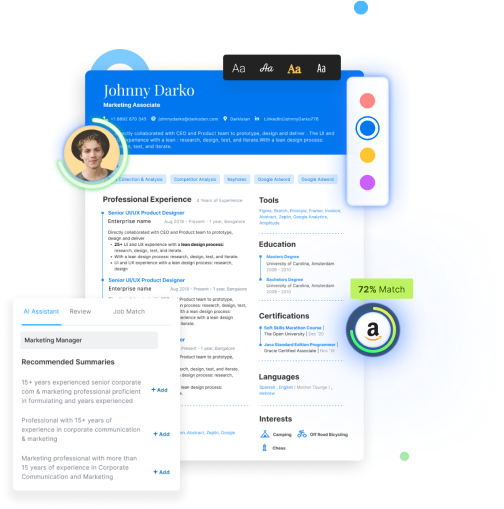How should a professional portfolio be structured to quickly impress recruiters?
Create skimmable case studies that state role, goal, and outcomes and visually show your process; align projects to target job requirements and link directly to the most relevant work. This focuses attention and proves fit fast.
Recruiters spend at the most 2 to 5 minutes reviewing a portfolio.
That’s all the time you have to make a strong first impression, communicate your skills, and prove you're the right fit.
Most portfolios fail right at this this initial stage - not because the work isn’t good, but because they bury the impact, lack context, or read like a personal archive instead of a pitch.
If you want your portfolio to get you noticed, you need structure, strategy, and clarity.
Here are 7 advanced steps to build a professional portfolio that grabs attention, tells your story, and gets results.
1. Craft Skimmable, High-Impact Case Studies
Recruiters don't read case studies; they scan for impact. To cater to this, structure your project pages for immediate clarity.
When a recruiter clicks on a project, they should immediately see a "Project Overview" box at the top. This scannable section must contain:
- Your Role: e.g., Lead Developer, Digital Marketing Manager, Project Lead.
- The Goal: e.g., "Refactor a legacy codebase," or "Increase Q4 lead generation."
- Key Outcomes: The "So what?" factor, answered upfront with metrics. For example: "Reduced page load time by 60%," or "Exceeded lead generation target by 35%, resulting in a 15% increase in sales-qualified leads."
This structure gives recruiters the bottom line immediately, proving your value before they have to scroll an inch.
2. Showcase a Visual & Scannable Process
Showing your process is vital for demonstrating how you think. A marketer can show the evolution of a campaign from initial brief to A/B testing results.
A developer can show architectural diagrams or snippets of challenging code. The key is to make it visual and skimmable.
Instead of writing long paragraphs, use annotated visuals: flowcharts, screenshots, or code blocks with brief, insightful captions.
This proves you did the work without forcing the recruiter to read a novel. The goal is to show evidence of strategic thinking, not to document every single step.

3. Reverse-Engineer Your Portfolio from Your Dream Job
Instead of just documenting what you’ve done, strategically build your portfolio based on where you want to go.
Find 3-5 job descriptions for the exact role you want to land next. Copy and paste these descriptions into a document and identify the top 5-7 required skills and qualifications that appear most frequently.
This is your roadmap. Now, review your past work and select or create case studies that directly prove you have these specific skills.
If a key skill is missing from your portfolio, consider doing a personal project to fill that gap.
This ensures your portfolio isn't just a history of your past, but a direct and compelling argument for your future.
4. Build for Everyone: Make Your Portfolio Accessible (a11y)
Most candidates overlook a critical step: building your portfolio with web accessibility in mind.
This means ensuring your site is navigable by keyboard, images have descriptive alt text, and text colors have sufficient contrast.
An accessible portfolio demonstrates meticulous attention to detail, empathy, and a modern, inclusive mindset.
In many tech and design fields, this is a required skill, and showcasing it in your own work is the ultimate proof of your capability and professionalism.
5. Guide the Recruiter: Tailor Your Portfolio Submission
Don't just send a generic link to your portfolio in your application. Assume the recruiter is too busy to search for the most relevant project. Do the work for them.
In your cover letter or email, include a sentence that directs them to the single most relevant case study. For instance: “My experience in B2B marketing is best demonstrated by my work on the XYZ campaign, which you can review here: [Direct Link to Project].”
This simple act shows you’ve read their job description carefully, you respect their time, and you can connect your skills to their specific needs, all before they even click the link.

6. Integrate "Social Proof" Directly into Your Projects
A separate "Testimonials" page is outdated. To create maximum impact, weave your social proof directly into the relevant case studies.
Just after you've presented the successful outcome of a project, insert a quote from the client, manager, or key stakeholder who was thrilled with that specific result.
This provides powerful, in-context validation of your work. If you've worked with well-known companies, add a "Trusted By" logo section to your homepage.
7. Prove Your Remote-Readiness: Showcase Independent Work
In today’s hybrid and remote workplace, proving you can communicate clearly and work independently is a massive advantage.
Use your portfolio to showcase your excellence in asynchronous work. Instead of only showing the final design or report, include artifacts that prove your process is organized and clear.
This could be a link to a GitHub repository with a perfectly written README.md file, a screenshot of a meticulously organized project board in Asana or Trello, or a copy of a detailed project update you sent to stakeholders that kept everyone aligned without needing a meeting.
This directly addresses a key concern for managers: "Can this person be trusted to deliver with less supervision?"
Conclusion
Your portfolio needs to be focused, strategic, and future-facing. By integrating these advanced techniques - like case study storytelling, social proof placement, and clear job alignment, you’re building more than a gallery.
You’re crafting a narrative that works for you.
And if you're looking for extra support, Hiration can help you polish the entire package, whether it’s refining your resume to match your portfolio, practicing mock interviews based on your showcased work, or ensuring your LinkedIn presence ties it all together.
A strong portfolio gets you noticed. A cohesive brand gets you hired!
Frequently Asked Questions
-
How long do recruiters spend reviewing a portfolio?
Recruiters spend 2 to 5 minutes reviewing a portfolio. Use that time to make a strong first impression, communicate your skills, and prove you're the right fit.
-
What makes a case study in your portfolio effective?
Structure project pages for immediate clarity and impact. Add a 'Project Overview' box with Your Role, The Goal, and Key Outcomes answered upfront with metrics.
-
How do you showcase your process in a portfolio?
Make your process visual and skimmable using annotated visuals like flowcharts, screenshots, or code blocks with brief, insightful captions. Show evidence of strategic thinking without documenting every single step.
-
How do you tailor your portfolio to your dream job?
Find 3-5 job descriptions for your target role and identify the top 5-7 required skills. Select or create case studies that directly prove you have those specific skills.
-
Why should you make your portfolio accessible?
Build with accessibility to show meticulous attention to detail, empathy, and a modern, inclusive mindset. Ensure keyboard navigation, descriptive alt text for images, and sufficient text color contrast.
-
How should you tailor your portfolio submission for applications?
Do not send a generic portfolio link. In your cover letter or email, include a sentence that directs them to the single most relevant case study with a direct project link.
-
How do you integrate social proof into portfolio projects?
Weave social proof directly into relevant case studies. After presenting outcomes, insert a quote from the client, manager, or key stakeholder, and add a Trusted By logo section if applicable.
-
How do you demonstrate remote-readiness with your portfolio?
Show remote-readiness by showcasing organized, clear asynchronous work artifacts. Include a GitHub repository with a perfectly written README.md, a project board screenshot, or a detailed stakeholder update that kept everyone aligned without needing a meeting.
-
What common mistakes make portfolios fail?
They bury the impact, lack context, or read like a personal archive instead of a pitch. These issues cause portfolios to fail in the initial stage.
-
What are the key steps to build a professional portfolio that gets results?
Craft skimmable case studies; show a visual process; reverse-engineer from your dream job; build for accessibility; tailor your submission; integrate social proof; and prove remote-readiness.



